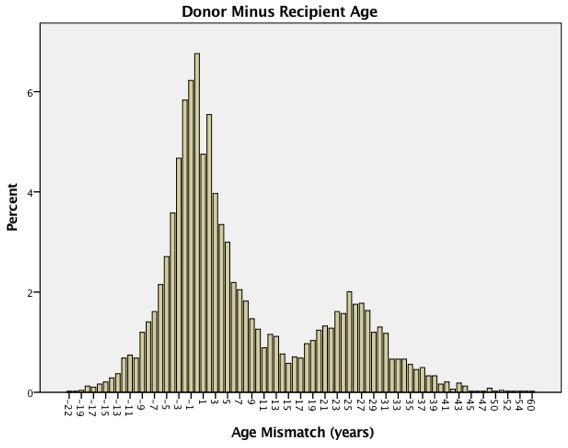Trends, Patterns, and Recipient Outcomes of Kidney Transplants from Older (>60) Living Donors. A UNOS Database Analysis
Indiana University, Indianapolis.
Meeting: 2018 American Transplant Congress
Abstract number: 220
Keywords: Age factors, Donation, Kidney transplantation, Survival
Session Information
Session Name: Concurrent Session: Kidney Living Donation: Donor and Recipient Outcomes
Session Type: Concurrent Session
Date: Monday, June 4, 2018
Session Time: 2:30pm-4:00pm
 Presentation Time: 2:54pm-3:06pm
Presentation Time: 2:54pm-3:06pm
Location: Room 6E
Backgroud: The selection of older donors (>60 years) has become more common. Our aim was to analyze the recent national trends of such donors and their recipient outcomes.
Methods: We analyzed the UNOS database for living donor transplants with donors above the age of 60 who donated between Jan 2000 thru Jun 2015. Out of a total of 95,439 donors, 4,836 donors => 60 (5.06%) were identified.
Results: There was an increasing number of older living donors over the study period in this cohort. 26.5% 2000-2005; 33.9% in 2006-2010 and 39.6% in 2011-2015 (p<0.05).
Mean donor age was 63.3+/-3.2 years(60-84). Majority of donors (78.3%) were between 60-65 years, while remaining 21.7% were > 65.Majority of donors were Whites (86%), females (63.4%), Hypertensive (8.6%). Relationship to Recipient was Spouse (29.2%); Sibling (18.1%); Parent (18%); Paired Donation (6.2%).
Majority of Recipients were males (61.5%). Mean Recipient Age 55.9+/-13.3 years. 51% of recipients were above 60 yrs, 0.4% recipients were < 18 years. Recipient DM 33.9% with 36.8% of pre-emptive (pre-dialysis) transplant. Re-transplants were 8.4%; The mean and median difference in age between donor and recipient was 7.4+/-13.1 (-22 to 60) ; 3.0 respectively.
There was a bimodal pattern to recipient age with biggest peak at age 65 and a second lower peak at age 37. There was also bimodal pattern to the difference in ages between donor and recipient with the biggest peak at a difference of 1year, and a second smaller peak at a difference of 25.  Mean HLA mismatch level 3.55+/- 1.65. Zero mismatch 7.1%.
Mean HLA mismatch level 3.55+/- 1.65. Zero mismatch 7.1%.
One year Reported Acute rejection rate was 9.0% ; Delayed Graft Function Rate 5.1%. Recipient Discharge Creatinine was 1.9+/-1.4mg.dl. 1yr, 5yr, 10 yr unadjusted Graft Survival was 95%; 77% ; 51%. Death-censored Graft Loss was 98%; 90% and 78% respectively.
There was significant difference in Recipient unadjusted Graft Survival when comparing Donors 60-65yr vs > 65yrs (p<0.005), but not in death-censored Graft Loss (p=0.730).
Conclusions: Transplantation from a older (>60) living donors is becoming more common and appears to be an excellent option for recipients.
CITATION INFORMATION: Riaz A., Adebiyi O., Yaqub M., Mishler D., Taber T., Sharfuddin A. Trends, Patterns, and Recipient Outcomes of Kidney Transplants from Older (>60) Living Donors. A UNOS Database Analysis Am J Transplant. 2017;17 (suppl 3).
To cite this abstract in AMA style:
Riaz A, Adebiyi O, Yaqub M, Mishler D, Taber T, Sharfuddin A. Trends, Patterns, and Recipient Outcomes of Kidney Transplants from Older (>60) Living Donors. A UNOS Database Analysis [abstract]. https://atcmeetingabstracts.com/abstract/trends-patterns-and-recipient-outcomes-of-kidney-transplants-from-older-60-living-donors-a-unos-database-analysis/. Accessed December 15, 2025.« Back to 2018 American Transplant Congress
